Arnold and Son TBR – Reviewed

Arnold and Son, a company who propelled the marine chronometer, celebrates its heritage with a modern interpretation, the TBR, which is the first release in their Instrument Collection. Its two complications, true beat and retrograde, provide the name TBR.
One might foolishly call this a watch, but true to a past design of John Rogers Arnold, the son in Arnold and Son, and collaborator Thomas Earnshaw, the TBR is a chronometric instrument. From when nautical navigation had a British mastery to now, when chronometer accuracy benefits from technological advances, Arnold and Son straddles the ages to create an instrument born of the sea.

The ocean is a fickle mistress. Sailors have knowledge of the ocean that extends beyond the horizon, whereas we often view the waves from the safety of a seaside villa, standing with our toes in the sand, entertaining romantic notions of adventure while sipping a cold beverage. Throughout the centuries, those who would navigate the ocean blue have understood the danger. What one day can be bathtub calm can another day churn into a mountainous fury of vengeance with skyscraper waves that seem to contradict all notions of religion. Even in our age of GPS and state of the art engineering, the ocean remains a capricious love; navigating these beguiling waters means having the right equipment.
The TBR’s legacy comes from the early days of the company when they were preeminent in providing marine chronometers to calculate longitude. The TBR harnesses its past, particularly with its true beat complication, and then reinterprets that past in a thoroughly modern execution.
Overall Appearance
The large arrow minute hand, jumping emphatically around the dial, makes the greatest impression, and reveals a tool watch’s heart. In terms of yesteryear functionality, the seconds were the most important feature, so the seconds dominate the TBR’s dial. Precision in reading the seconds was helpful for setting clocks across the ship as well as improving accuracy for longitude navigation. The sexagesimal system (i.e. in degrees, minutes and seconds) used to determine geographical position meant that reading true seconds was crucial for navigation. The TBR showcases the seconds in a masterful reinterpretation of an older design.

Think it looks like a quartz watch? Think again. The TBR has one of the most difficult mechanical complications, the true beat. The true beat complication resembles the movement of a quartz watch, but a quartz watch jerks in its jumps, whereas the TBR shifts solidly into place.
The rhythmic demarcation of the true beat complication, visible with each tick, the arrow point stopping directly over the chapter ring’s dots, communicates time with exactitude. With the immense arrow hand, attached past its midpoint and extending on either side of the dial, you cannot help but notice how it jumps.
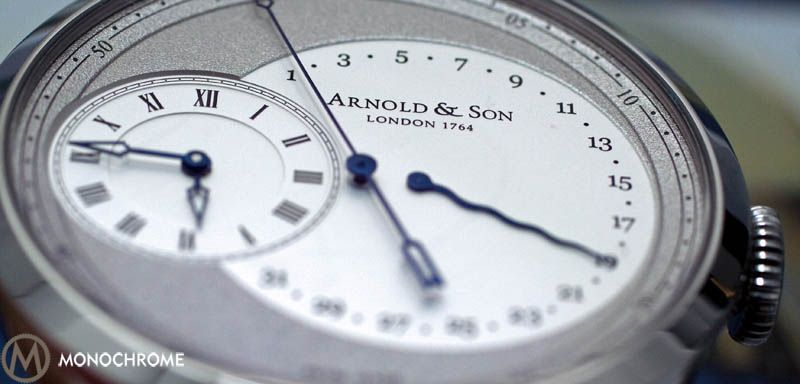
Next to the large arrow hand, the spacious dial arrests your attention. This instrument is all about scale. Like a Venn diagram, the sunken sub-dials overlap. The white of these sub-dials pops against the speckled, opaline silver dial. Against this backdrop, in true marine chronometer fashion, the hands are heat treated blue, but here each has a different shape for a different function. The seconds hand is a large arrow, the date hand is serpentine and the minute/hour hands are miniature arrows.
The appearance and quality of the dial is stunning. The large open dial brings its ascetics to the forefront, allowing the TBR’s luxurious refinement to take center stage.
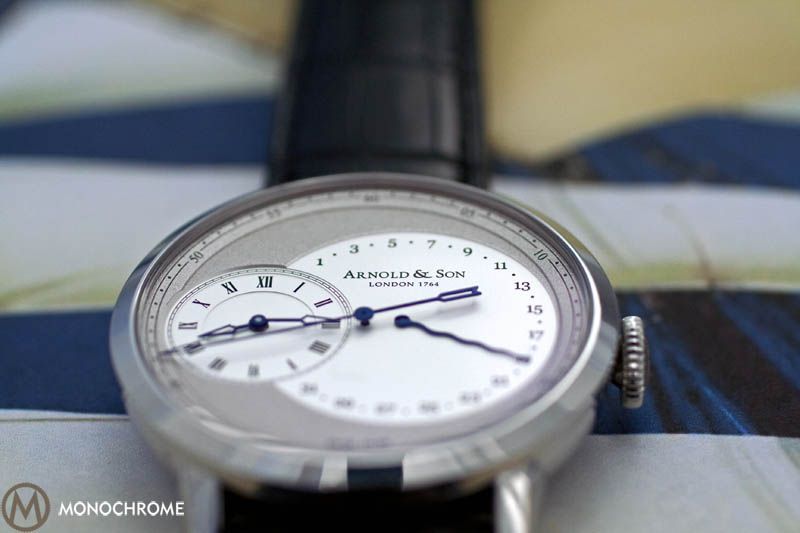
Features
The Retrograde function regulates the date display. Retrograde is a technical term, which indicates that a hand will snap back to the beginning once it reaches the end. My observation of the retrograde date function, however, revealed a snapping motion too fast for the eye to follow. The return happened so quickly that the serpentine hand’s movement from the 31st to the 1st seemed clockwise, but in fact, the retrograde hand returns counter-clockwise, which is the only way back, because of the central second hand’s stem.
The True Beat, or “jumping seconds” or “seconde morte” (dead seconds), complication is a very difficult complication to achieve. Its origin lies in pendulum clocks of the 1700s followed by pocket watches in the latter half of the century, and its second-by-second movement is a forerunner of the chronograph.
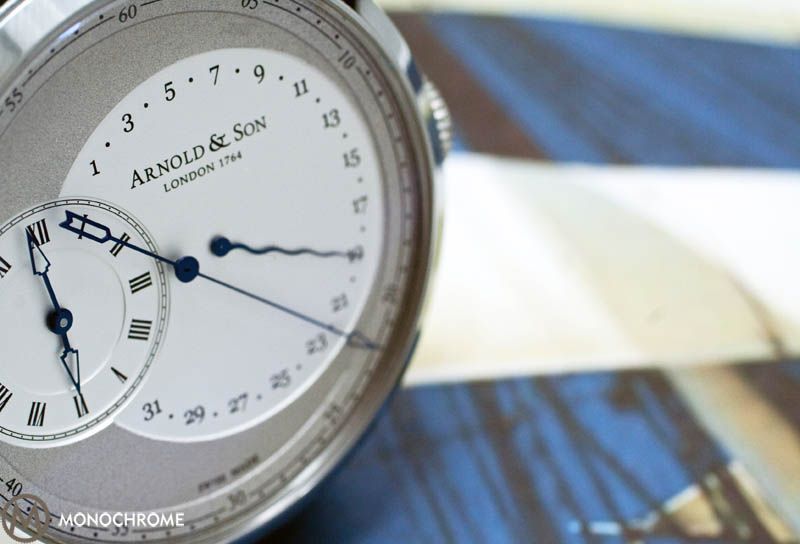
Dial/Hands
The dials cascade downward from seconds to date to hours/minutes. The large arrow seconds sits high enough to cast a shadow across the dial, which visually creates an even larger impression, almost clock-like. The true beat seconds hand takes top billing with the retrograde complication coming next, and these two complication dominate the dial with the minutes/hours regulated to the smallest sub-dial. This made telling time counter-intuitive as the seconds were most prominent, and I had to hunt for the time. It got easier and I also learned to appreciate, no to love, the artful presentation of time and enjoyed observing the march of the seconds. Is this the most practical layout? No, the layout that Grönefeld has chosen for their One Hertz looks far more practical. However practical is an anachronistic consideration, which is the appeal of having such an instrument.

Case/Strap
The case telescopes to the wrist with the lugs extending from the second terrace and turned downward. When the TBR is placed on its back, the lugs resemble the legs of a table, and it looks like the instrument has its own stand. The outer bezel slopes downward like the edges of a lens, and the overall case resembles a collapsed spyglass. My model had a stainless steel case, but it is also available in 18-carat rose gold.
The crown is oversized, relatively flat, and adorned with a polished coin edge. Its size and the absence of a screw-down feature make winding a cinch. Against the satin silver head sits the polished company logo of an anchor encased in a crown, floating on the sea. The logo celebrates the work John Arnold did for the Royal Navy.

The strap is a supple, high grade leather with a comfortable feel. Though mine was the leather strap, it is also available in alligator. The biggest disappointment was the buckle. Though I was initially disappointed over the absence of a deployment buckle, the sheer beauty of the buckle won me over. It is handsomely shaped displaying the nautical logo that can also be found on the crown, rotor and interior bridge. The problem is with using the buckle. With the buckle being thin, and with the rise just above the logo, the buckle had a nasty habit of digging in under the nail when fastening and unfastening the strap. Ouch.

Movement
In case you didn’t know the TBR was special from looking at the dial, one look at the movement, and you may find it hard to turn it back over. If the devil is in the details, then the TBR has mastered the details, allowing a glimpse through a sapphire case back into something akin to perfection. Wow. Rhodium plating, hand chamfered bridges and edges, and enough variations of decoration as to become a trivia contest: Côtes de Genève, pèrlage, brushed, sunburst, and polished. The skeletonized rotor insures an uninhibited view of all below as it glides. I Ioved seeing the lever escapement under the balance wheel, and I wish more movements allowed this glimpse. From whatever angle I viewed the TBR, one word came to my lips, ART, and the movement solidified this conclusion.
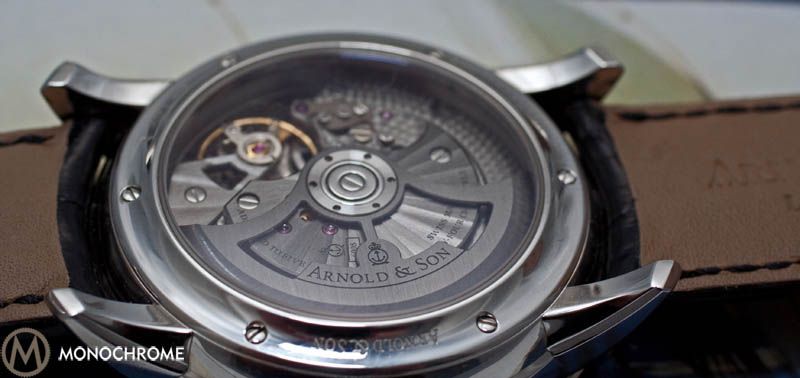
The hand-finished A&S6008 caliber is an in-house movement, nurtured from development to design to production. This is the first true beat complication to be vertically integrated at the workshops in La Chaux-de-Fonds. Housing a true beat complication with an automatic winding system is a modern engineering marvel. The automatic winding system is bi-directional, winding in two directions for efficiency, and it has seven ceramic ball bearings to reduce friction. How to combine the two?
In the TBR it was made possible by a worldwide patented system comprising a sophisticated double wheel, an oscillating pinion and a pallet mechanism. This complex solution calls for virtually microscopic precision (to tolerances of a micron, or one thousandth of a millimetre) and the key parts are made using state-of-the-art LIGA fabrication technology. LIGA is a German acronym that stands for Lithographie, Galvanoformung, Abformung – lithography, electroplating and moulding – and describes the sequence of processes used to produce metal parts made of nickel and nickel phosphorus.
The LIGA technology also enables the swift, definitive advance of the date with patented dents sans jeu (literally, teeth without play – or gaps). Though the TBR takes its inspiration from the past, it is equipped with modern technology.
Pardon me, but is that a watch strapped to your wrist? Absolutely not! This is a chronometric instrument!
The TBR was a favorite. We share a nostalgia for the ocean. Like a trophy wife on your arm garnering the admiration of the crowd, this watch, err instrument, adorns the wrist without rivals. Its sheer beauty holds your attention as the seconds tick away, one jump at a time, and provides continuous nuances to discover. Wearing the TBR was a bit like falling in love…
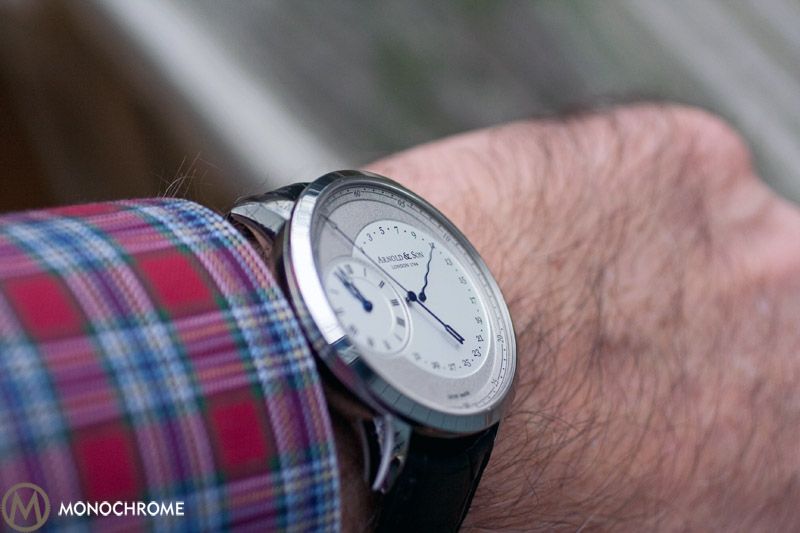
The Verdict: Pros and Cons
Pro:
- Successful reinterpretation of a marine tool watch
- The true beat and retrograde complications
- The speckled silvery dial
- The ornate movement
- The telescopic case
- The large crown with logo
- The Japanese conglomerate, Citizen, purchased Arnold and Son, but A&S still retains its independent identity and operation. With tradition an appeal of the brand, it nice to know nothing has changed operationally.
Con
Not just the lack of a deployment clasp, but a thin buckle that though beautiful in appearance leaves much to be desired in finger ergonomics
TBR – Main technical characteristics:
Calibre A&S6008 – Exclusive Arnold & Son mechanical movement, self-winding, ceramic ball bearing, 34 jewels, diameter 30.4 mm, thickness 7.79 mm, power reserve 50 h, 28’800 vibrations/h, stop seconds
Functions: hours, minutes, true beat seconds, retrograde date
Movement decoration:
- 18-carat rose gold case model: rhodium treated with Haute Horlogerie finishing: manually chamfered, bridges with polished edges, fine circular graining and Côtes de Genève rayonnantes, brushed and skeletonised rotor, blued screws
- Stainless steel case model: NAC grey treated, with Haute Horlogerie finishing: manually chamfered bridges with polished edges, fine circular graining and Côtes de Genève rayonnantes, brushed and skeletonised rotor, mirror-polished screws
Dial colour: silvery white and silvery opaline / light-grey and silvery opaline
Case: 18-carat rose gold or stainless steel, diameter 44 mm, cambered sapphire with anti-reflective coating on both sides, case back see-through sapphire, water- resistant to 30 m
The 18 carat rose gold version comes at a retail price of $29,350 and the stainless steel version costs $19,750. More info through the Arnold & Son website.



